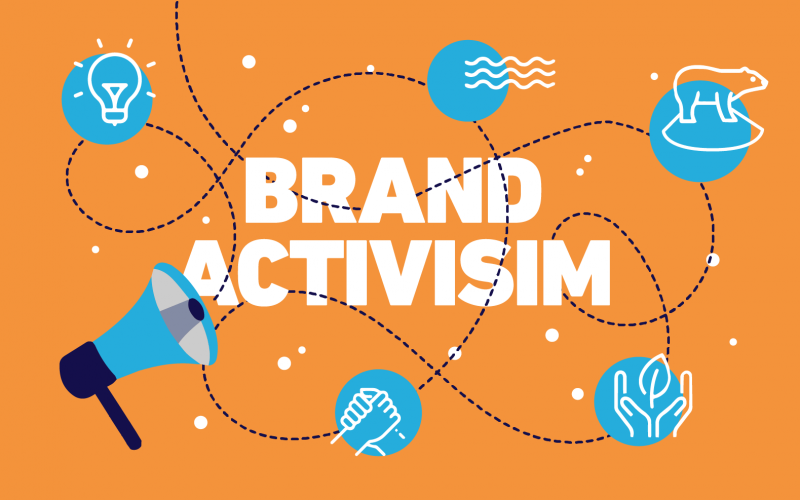Brand activism is one of the most powerful and influential marketing strategies. This concept extends beyond standard advertising by compelling corporations to take a position on social, environmental, or political issues. When done right, brand activism not only elevates the brand but also drives genuine social change. As someone who has witnessed the transforming effect of these initiatives firsthand, I’m thrilled to present five exceptional examples of brand activism that have actually altered the world. And believe me when I say that the third campaign on our list has had an incredible impact!
What is Brand Activism?
Brand activism is defined as firms taking a public stand on issues they believe in.
The activism could support social, political, and/or environmental causes, and it is usually more public-facing and action-oriented than Corporate Social Responsibility (CSR) and Environmental, Social, and Governance (ESG) programs, which are typically integrated into internal operations.
Brand activism can be proactive or reactive. Reactive activism typically responds to real-time news reports, current events, or a national discourse, whereas planned activism enables brands to include the activation in larger marketing activities. Both forms allow brands to participate in live discussions with audiences and communicate their opinion on a particular issue.
There are numerous venues where brand activism can take place. Some businesses, such as Ben and Jerry’s, may choose to take a political stance through their products. Others will take a stand through a television ad campaign or social media material, such as a TikTok video or a tweet.
Why Does Brand Activism Matter?
The most crucial reason to execute brand activism in your firm is to affect social change and make the world a better place to live! The truth is, that becoming an activist may benefit more than simply the environment. Here are some additional benefits that brands may enjoy when they engage in social responsibility:
- Increased trust among consumers who share your brand’s beliefs.
- Setting oneself apart from competitors who do not involved in activism.
- Enhanced brand visibility via third-party blogs, news sites, and influencers who share your beliefs.
Brand activism can also boost brand loyalty, resulting in more repeat customers and more profitability. 49% of consumers currently consider themselves “brand loyal,” and here are some of the top reasons why customers will stick with a particular brand.
The most influential brand activism attributes are:
- The brand and/or its products adhere to their health and safety standards. 29%
- Brand is local 24%.
- Committed to sustainability (21%).
- Represents a lifestyle they identify with (21%).
- Product recalls are 20% lower than competitors.
- Represents ethical standards they support: 20%
What Brand Activism is Not
Although many customers like brands that promote social change, 15% report that brand activism hurts their perception of a brand. As a result, we recommend being cautious about what and how you promote to avoid alienating clients.
Have you ever been watching your favorite TV show and suddenly felt as if the producers’ opinions were being forced on you with no obvious purpose or objective to the message (looking at you, Grey’s Anatomy)? This same sensation might arise when a brand publicizes its thoughts without taking any action to affect societal change.
Effective brand activism requires a significant amount of effort and thought. It’s not as simple as including a “we love the planet” emblem in your marketing campaign. Consumers are astute and quick to call out greenwashing and other deceptive brand activism methods, such as stating your product is environmentally friendly when it isn’t.
Keep in mind that honesty is the best policy, and the proof is in your actions, not your words. Do not claim to be an activist if you are not contributing time, money, and effort to the cause. Consumers will see right through this and be turned off by your brand, resulting in lost sales and confidence.
Step-by-Step Guide to Launching a Successful Brand Activism Campaign
A successful brand activism campaign necessitates a planned strategy as well as a real dedication to the cause. Here’s a step-by-step guide to assist you traverse this adventure successfully:
Step #1. Find a Cause That Matches Your Brand Values
Authenticity is essential to every effective brand activism effort. Your selected cause should organically complement your brand’s basic beliefs and objectives. This guarantees that your activism is real and resonates well with your target audience. For example, if your brand is concerned with sustainability, supporting environmental issues can strengthen your devotion and authenticity.
Step #2. Conduct thorough research
Understanding the nuances of the cause you support is critical. Conduct an extensive study to fully understand the topic, including its history, significant participants, and present challenges. This insight will help you develop an informed and effective campaign. For example, while supporting a social justice cause, understanding its origins and current landscape aids in the development of relevant messages and activities.
Step #3. Collaborate with Relevant Organizations
Partnering with existing organizations or nonprofits linked to your cause might help you gain credibility and amplify your impact. These collaborations can bring essential resources, insights, and networks to help your campaign move forward. The collaborations can also help you reach a larger audience and build trust quickly.
Step #4. Create a Clear and Compelling Message.
Create a message that is straightforward, appealing, and capable of motivating action. Your message should not only emphasize on the problem, but also communicate your brand’s dedication and the particular steps you’re taking to fix it. A well-written message can elicit emotions and persuade your audience to embrace your cause. A statement about the impact of plastic waste, for example, can highlight your brand’s efforts to reduce plastic consumption.
Step #5. Use Multiple Channels to Amplify Your Message
Use many marketing methods to distribute your word far and broad. This may involve social media, email campaigns, news releases, and even traditional media. Each platform should consistently convey your campaign’s main theme and ideals. Using several platforms guarantees that your message reaches a diverse audience and has the most impact.
Step #6. Engage Your Audience
Actively involve your audience by encouraging participation and comments. This can be accomplished with interactive content, social media challenges, or community activities. Engaging your audience promotes a sense of community and shared purpose. For example, organizing a social media challenge in which people share their efforts to promote the cause can boost engagement and raise awareness.
Step #7. Measure and Reflect.
Regularly assess the effectiveness of your campaign using relevant indicators. This can include social media interaction, website traffic, and any tangible results for your cause. Reflect on what worked and what didn’t to continuously improve your approach. Analyzing the data allows you to better understand the efficacy of your campaign and make improvements for future initiatives.
By following these steps, you can create a strong brand activism campaign that not only helps a great cause but also deepens your brand’s relationship with its target audience. Are you prepared to have a good influence with your brand? Please share your opinions, and let us talk about how we can work together to drive change.
5 Brand Activism Campaigns That Changed the World
#1. Nike’s “Dream Crazy” Campaign
Nike’s “Dream Crazy” commercial, which included Colin Kaepernick, was a bold move that emphasized racial injustice and social justice. Nike ignited a global discourse by standing up and supporting Kaepernick, who faced outrage for kneeling during the national anthem to protest police brutality and highlighted its brand values of courage and equality.
#2. Ben and Jerry’s: Climate Justice
Ben & Jerry’s has long been recognized for its dedication to social and environmental issues. Their climate justice campaign aimed to increase awareness of global warming and advocate for policy changes. They used their platform to educate customers, persuade policymakers, and effect tangible change, demonstrating how companies can use their power for good.
#3. Google will delete users’ history on abortion clinics.
Google’s recent decision to delete location records for people visiting abortion clinics is an excellent example of reactionary brand activism. Rather than simply tweeting or campaigning, it actively sought to improve the operation of its product to safeguard its users.
The events of Roe v Wade, in which the Supreme Court terminated the right to abortion in the United States, sparked global outrage. The discourse spread throughout the business sector, leading organizations to consider their own stance on the subject.
The society urged the technology industry to safeguard people from police getting critical information about their pregnancy plans.
Google took a stand and decided to change how they handle sensitive information about abortions – if their systems detect that someone has visited an abortion clinic, they “will delete these entries from Location History soon after they visit”.
Google’s approach is an example of a tech behemoth using its power to safeguard women, and it is the first tech corporation to openly state how it will manage user data in response to worries about the court ruling and how it can be weaponized and imposed by law enforcement.
#4. Patagonia: “The President Stole Your Land”
Patagonia strongly opposed the Trump administration’s move to cut the extent of national monuments. Their slogan, “The President Stole Your Land,” was straightforward and unapologetic, encouraging shoppers to take action and fight for environmental protection. This courageous approach not only appealed to their ecologically sensitive audience but also established a precedent for corporate activism.
#5. Always, #LikeAGirl
The Always #LikeAGirl campaign aims to challenge gender stereotypes and inspire young girls. By rethinking what it meant to act “like a girl,” Always questioned cultural standards and encouraged girls to embrace their abilities. The campaign had a significant influence, promoting a more inclusive and empowering environment for women and girls worldwide.
Key Takeaways
- Successful brand activism initiatives are strongly based on a company’s basic beliefs and mission.
- Understanding the complexities of the cause you support is critical for developing effective and informed campaigns.
- Working with relevant groups can boost your efforts and provide credibility to your cause.
- Actively engaging with your audience builds a sense of community and shared purpose.
- Regularly measuring the impact of your campaign and reflecting on your strategy allows you to constantly improve your strategies.
Ready to make a difference with your brand? Download our Brand Activism Campaign Planning Template now and start crafting your impactful campaign today! This comprehensive template will guide you through each step, ensuring your efforts are authentic, effective, and resonate with your audience. Don’t miss out on the opportunity to drive real change and strengthen your brand’s connection with its community.
Template for Brand Activism Campaign Planning
Conclusion
Incorporating brand activism into your marketing plan not only improves your brand’s reputation but also helps to effect genuine societal change. By taking bold statements and aligning with issues that fit your brand’s beliefs, you can build strong relationships with your audience and have a huge effect. What cause will your brand support next?
Related Articles
- Brand Advertising: Elevating Your Brand Awareness
- How To Measure Brand Awareness: KPIs To Look Out For
- HOW TO LAUNCH A SUCCESSFUL INTERNAL MARKETING CAMPAIGN: Tips and Techniques
- How To Do Rebranding Campaign Effectively: Expert Ideas!!
- The Campaign Optimization Secrets Big Brands Don’t Want You to Know






